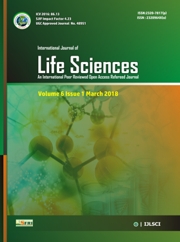ORIGINAL ARTICLE
Volume 9 |Issue 6| Novmber-December 2021 First published: 30 December 2021
Isolation and characterization of dynamic plant growth promoting microorganisms from rhizosphere
Bhusare Deepak U
Department of Microbiology, Digambarrao Bindu ACS College, Bhokar, Dist. Nanded (MS), India-431801.
Email: bhusaredu@gmail.com
Abstract
Keywords:Bio-inoculant, Rhizospheric microorganisms, biochemical study, soil samples, PSM.
Editor: Dr.Arvind Chavhan
Cite this article as:
Bhusare Deepak U. Isolation and characterization of dynamic plant growth promoting microorganisms from rhizosphere, Int. Res. Journal of Science & Engineering, 2021, Volume 9(6): 169-175.
References
1. Ogunmwonyi IN, Igbinosa OE, Aiyegoro OA and Odjadjare EE. Microbial analysis of different top soil samples of selected site in Obafemi Awolowo University, Nigeria. Scientific Research and Essay, 2008; Vol. 3 (3), pp. 120-124.
2. Xinxiang Xu, Xin Du, Fen Wang, Jianchuan Sha, Qian Chen, Ge Tian, Zhanling Zhu, Shunfeng Ge and Yuanmao Jiang. Effects of Potassium Levels on Plant Growth, Accumulation and Distribution of Carbon, and Nitrate Metabolism in Apple Dwarf Rootstock Seedlings. Frontiers in Plant sciences, 2020.
3. Arjun Dev Jnawali, Roshan Babu Ojha, Sushma Marahatta. Role of Azotobacter in soil fertility and sustainability–a review. Advances in Plants & Agriculture Research, 2015; Vol. 2 Issue 6.
4. Bruno Streit. Effects of high copper concentrations on soil invertebrates (earthworms and oribatid mites): Experimental results and a model. Springer, 1984, 64:381-388.
5. Nilde Antonella Di Benedetto, Daniela Campaniello, Antonio Bevilacqua, Mariagrazia Pia Cataldi, Milena Sinigaglia, Zina Flagella and Maria Rosaria Corbo. Isolation, Screening, and Characterization of Plant-Growth-Promoting Bacteria from Durum Wheat Rhizosphere to Improve N and P Nutrient Use Efficiency. Microorganisms, 2019, 7, 541.
6. Xuan Yu & Xu Liu & Tian Hui Zhu & Guang Hai Liu & Cui Mao. Isolation and characterization of phosphate-solubilizing bacteria from walnut and their effect on growth and phosphorus mobilization. Biol Fertil Soils, 2011, 47:437–446
7. Akhtar MS, Siddiqui ZA. Effects of phosphate solubilizing microorganisms and Rhizobium sp. on the growth, nodulation, yield and root-rot disease complex of chickpea under field condition. Afr J biotechnol , 2009, 8:3489–3496.
8. Hemant J. Patil and Manoj K. Solanki. Microbial Inoculant: Modern Era of Fertilizers and Pesticides. Microbial Inoculants in Sustainable, 2016, PP 319-343.
9. Johri JK, Surange S, Nautiyal CS. Occurrence of salt, pH, and temperature-tolerant, phosphate-solubilizing bacteria in alkaline soils. Curr Microbiol., 1999, 39:89–93.
10. Aneja KR. Experiments in Microbiology, Plant Pathology and Biotechnology: Fourth edition (2005), New Age International (P) Limited, Publisher.
11. Dubey RC and Mahesgwari DK (2019) Practical Microbiology. S. Chand Publisher.
12. Yoav Bashan (1998) Inoculants of Plant Growth-Promoting Bacteria for Use in Agriculture. Biotechnology Advances, Vol. 16, No. 4, pp. 729-770.
13. Ahsanur Rahman, Most. Ferdousi Begum, Matiur Rahman, MA Bari, GN M. Ilias, M. Firoz Alam. Isolation and identification of Trichoderma species from different habitats and their use for bioconversion of solid waste. Turk J Biol, 2011, 35, 183-194.
14. Karthikeyan Arumugam, Parthasarathy Ramalingam, Manikandan Appu. Isolation of Trichoderma Viride and Pseudomonas Fluorescens organism from soil and their treatment against rice pathogens. J. Microbiol. Biotech. Res, 2013, 3 (6):77-81.
15. Montoya-Gonzalez AH, Quijano-Vicente G, Morales-Maza A, Ortiz-Uribe N and Hernandez-Martinez R. Isolation of Trichoderma Spp. from Desert Soil, Biocontrol Potential Evaluation and Liquid Culture Production of Conidia Using Agricultural Fertilizers. J Fertil Pestic, 2016; 7:1.
16. Steyaert JM, Weld RJ, Stewart A. Ambient pH intrinsically influences Trichoderma conidiation and colony morphology. Fungal Biol., 2010; 114: 198-208.

